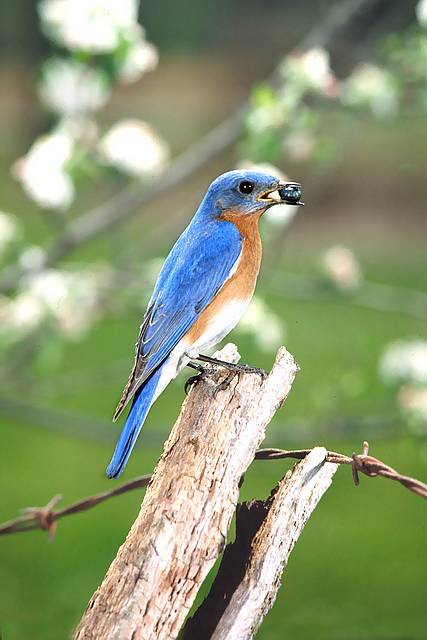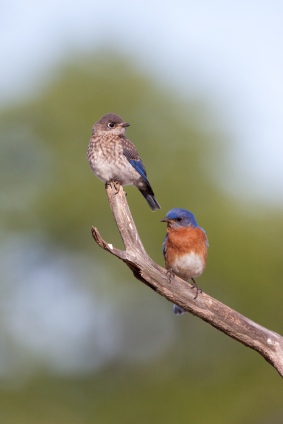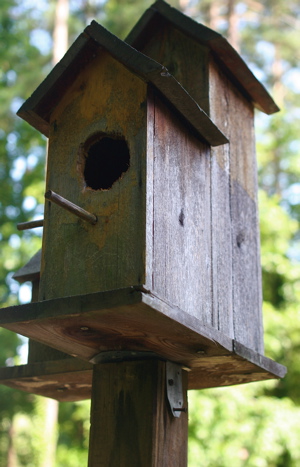- Bird Houses, Blue Bird Houses, Bluebird Houses, Uncategorized, Unique Birdhouses, Vinyl with Copper Roof Birdhouses
bluebird houses crafted in vinyl last a lifetime!
Here in this southeastern back yard, the Bluebirds never left, they over-wintered as our accommodations provided them well through a frigid winter season. Live mealworms were (and still are) fed daily, and bird baths remained heated throughout winter months. Lots of roosting spots, including several bluebird houses helped them keep warm at night.
Although wood is always good for most bird houses, over time it tends to weather and rot… which is not so good for prospective tenants. On the other hand, vinyl houses (like the kind people live in) pretty much last forever.
There’s a new breed of bluebird houses crafted to do just that… last forever! Architectural Bluebird Houses in white vinyl are an attractive and affordable alternative if replacing old nest boxes. Since they’re hand made (in the USA) there’s always a color choice for the roof too. Exterior grade plywood is covered in a coated aluminum to provide durability beyond compare. Roofs are available in bronze (shown here), verdigris and hammered copper options. With meticulous construction, and inert materials, these vinyl bluebird houses will last a lifetime, hosting many successful broods over the years.
One other thing on bluebird houses: as a rule of thumb, houses should be placed in open areas, at least one hundred feet apart, as bluebirds are
quite territorial. But if there is competition from swallows or other birds for the same house, placing another nest box about ten to fifteen feet apart will in many cases, make both parties happy!
-
bluebird houses alone may not cut it
The “Bluebird of Happiness” is one special little songbird that many backyard birders try to entice to their yards. The task can sometimes prove fruitless without the right combination of elements.
First there’s shelter, in the form of nest boxes, or bluebird houses. But don’t expect success with just slapping up a house. Proportionally-sized for Eastern and Western Bluebirds, these houses have certain features required for a successful brood. A predator guard is a plus, and having a duplicate bluebird house nearby may help with the fierce competition by non-native birds like the House Sparrow. Placement is important too, as Bluebirds prefer their nest boxes in open spaces. Shelter also involves cover, protection from predators in the form of mature trees and shrubs.
Now bluebird houses can run the gamut from your basic nest box (which serv
es the purpose well) to detailed copper roof houses, and decorative artisan’s works. The main thing is proportion and size, and drainage. Some bluebird houses will have a raised screen on the floor to prevent parasites, others have built in predator guards, and some have clear acrylic viewing windows to check the progress of nestlings without disturbing them. Some may have all these features, while others may have none of them. You usually get what you pay for in this instance, but again, a basic nest box will
likely do the trick.
Next is the feeder…Bluebirds are not seed eaters, and are not very likely to frequent this type of bird feeder. Traditional bluebird feeders are a “fly-in” style. They have have holes for the birds to enter and leave. Not many other species will use this kind of feeder…don’t ask me why bluebirds do! On occasion, I’ve seen Black Capped Chickadees enter our feeder in search of the coveted live mealworms. Tray feeders will also entice bluebirds if their favorite foods are offered. Number one choice…live meal worms. Once discovered, they’ll usually stick around for a daily offering of the juicy treat.
The last recommendation would have to be a birdbath. Fresh water offered on a consistent basis has got to be the single, most effective way to attract any wild birds. Especially in winter, a heated bath is a popular hangout where you’ll see many grateful little songbirds! Last winter, our Eastern Bluebirds over-wintered, and toughed out one of the most miserable winter seasons i can remember. Largely because of the heated bird baths, and live meal worms which were fed twice daily. Two successful broods last spring were truly a joy to watch fledge and grow. Once success is achieved…you’ll be hooked on Bluebirds…Happy Birding!
- Bird Accessories, Bird Houses, Blue Bird Houses, Bluebird Houses, Decorative Bird Houses, Uncategorized, Wood Birdhouse
Got Squirrel Damage to Blue Bird Houses?
Okay…so this may not be a bluebird house, but it does represent a typical squirrel-enlarged entrance. Has this happened to any of your birdhouses?
Early fall is the perfect time to clean birdhouses in preparation for winter. Resident birds like chickadees, titmice, and wrens will use houses to roost on cold winter nights. Our bluebirds actually stuck around and over-wintered here in North Georgia last year, so blue bird houses should also receive a thorough cleaning.
An old spatula works well to remove nesting materials, and makes the perfect scraper to remove stuck-on debris. Discard nest material away from the birdhouse, as this will likely attract predators. For the safety of your health, never breath in the dust from the nest materials either. Rubber gloves are helpful too.
To salvage an enlarged entrance and restore your birdhouses, predator guards are available. Simple metal portals work well, and fit right over the entrance, denying large birds or squirrels back inside the house. Two small nails will tack these down securely and in a jiffy! Decorative predator guards are also available, and will undo the damage done to your birdhouse.






